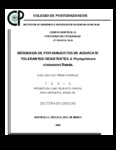| dc.description.abstract | México se considera el centro de origen del aguacate y mantiene diversidad genética
en materiales criollos. En este estudio, se realizaron colectas de semilla para detectar
tolerancia o resistencia a Phytophthora cinnamomi Rands, principal patógeno de la raíz
del aguacate. El material se colectó en los estados de Querétaro, Puebla y Estado de
México, seleccionando árboles que no mostraban síntomas (árboles “escape”) aún
cuando los huertos están infestados con el patógeno. Además, se incluyeron en la
investigación semillas de 22 accesiones del Banco de Germoplasma (BG) de la
Fundación Salvador Sánchez Colín CICTAMEX S.C. y planta clonal del portainjerto
Duke-7 resistente a P. cinnamomi y utilizado como testigo. Se inocularon 5,200
plántulas con micelio de P. cinnamomi para hacer una selección masal recurrente;
treinta y ocho plantas mostraron potencial para utilizarse como portainjerto. Para
evaluar el polimorfismo entre genotipos, caracterizarlos y detectar la cercanía entre
individuos, de los 38 materiales seleccionados, se extrajo el ADN y se caracterizó
molecularmente con RAPD e ISSR; se incluyeron también los materiales: Topa-topa
(susceptible), Duke-7 (resistente) y Day resistente a P. cinnamomi y salinidad,
provenientes del BG y utilizados como referencia. Los dendogramas se elaboraron con
el programa FreeTree, versión 0.9.1.50, aplicando un método de remuestreo con 1,000
repeticiones. La similitud genética se estimó con el coeficiente Nei and Li, y para los
agrupamientos se utilizó el método UPGMA. Trece de los 25 iniciadores presentaron
polimorfismo; el promedio del contenido de información polimórfica (PIC) para RAPD e
ISSR fue de 0.9052 y 0.9054, respectivamente, con un total de 3,057 bandas. De forma
independiente se caracterizaron 16 accesiones de aguacate provenientes del BG, 14
de ellas con resistencia o tolerancia en campo a P. cinnamomi y dos con
susceptibilidad al patógeno. El análisis detectó un alto grado de polimorfismo entre los
materiales evaluados.________México is considered as the origin center of the avocado and maintain genetic diversity
in wild materials. Seed collections were carried out to find tolerance or resistance to
Phytophthora cinnamomi Rands, main pathogen of the avocado root. The collection
sites were the states of Queretaro, Puebla and state of Mexico, where “escape” trees
were selected in orchards infested whit the pathogen, likewise, in this research there
were included seeds of 22 accessions from the Germplasm Bank (GB) located in
Coatepec Harinas, state of Mexico, y clone plant Duke-7 as standard. After five years
from the beginning of the collection, the outcome was 5,200 seedlings that were
inoculated with P. cinnamomi through recurrent mass selection. From this selection, 38
plants survived and are considered as potential of rootstock. Likewise, there were
materials selected to water with salty water with concentrations up to 14.2 meq/L of Na+
and 4.52 meq/L of Cl-. From these 38 materials, the DNA was extracted and
characterized molecularly with RAPD and ISSR, which includes three materials from the
Germoplasm Bank used as reference: Topa-topa (susceptible), Duke-7 (resistant) and
Day resistant to P. cinnamomi and salinity as well. The objective was to evaluate the
polymorphism among genotypes, characterize them and detect a close relationship
among individuals. The Dendograms (trees) were constructed with the software
FreeTree, version 0.9.1.50 considering a re-sampling method with 1 000 replications.
The close genetic relationship was estimated by Nei and Li coefficient, and the cluster
analysis was analyzed by the UPGMA method. Only 13 of 25 primers showed
polymorphism; the average of the polymorphic information content for RAPD and ISSR
was 0.9052 and 0.9054, respectively, with a total of 3,057 bands. Other study was by
vegetal culture of 16 accessions from the GB, 14 resistant to P. cinnamomi in field, this
analysis detected a high degree of polymorphism among materials assessed. | es |

